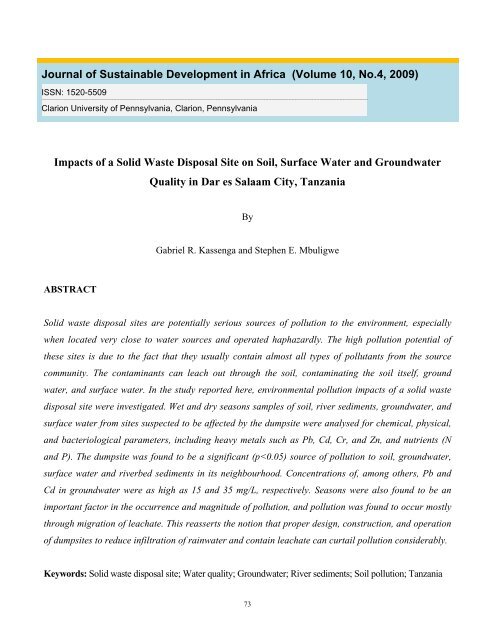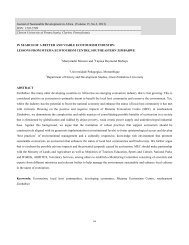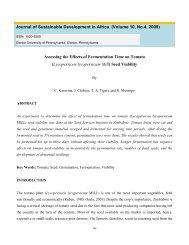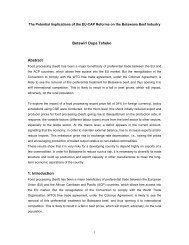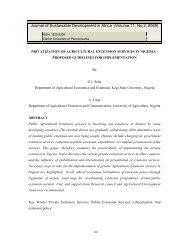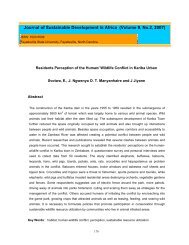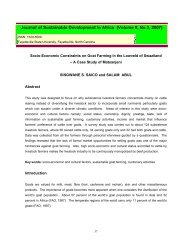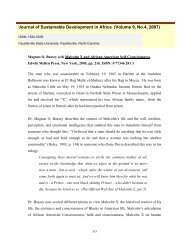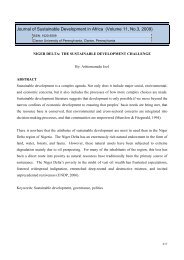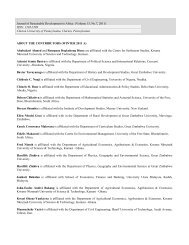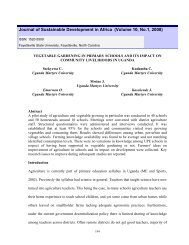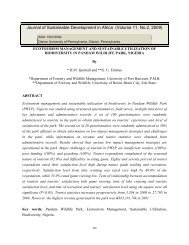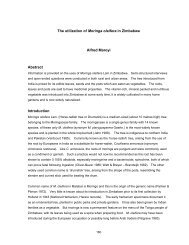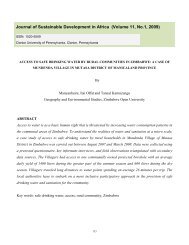Impacts of a Solid Waste Disposal Site on Soil, Surface Water and ...
Impacts of a Solid Waste Disposal Site on Soil, Surface Water and ...
Impacts of a Solid Waste Disposal Site on Soil, Surface Water and ...
You also want an ePaper? Increase the reach of your titles
YUMPU automatically turns print PDFs into web optimized ePapers that Google loves.
Journal <str<strong>on</strong>g>of</str<strong>on</strong>g> Sustainable Development in Africa (Volume 10, No.4, 2009)<br />
ISSN: 1520-5509<br />
Clari<strong>on</strong> University <str<strong>on</strong>g>of</str<strong>on</strong>g> Pennsylvania, Clari<strong>on</strong>, Pennsylvania<br />
<str<strong>on</strong>g>Impacts</str<strong>on</strong>g> <str<strong>on</strong>g>of</str<strong>on</strong>g> a <str<strong>on</strong>g>Solid</str<strong>on</strong>g> <str<strong>on</strong>g>Waste</str<strong>on</strong>g> <str<strong>on</strong>g>Disposal</str<strong>on</strong>g> <str<strong>on</strong>g>Site</str<strong>on</strong>g> <strong>on</strong> <strong>Soil</strong>, <strong>Surface</strong> <strong>Water</strong> <strong>and</strong> Groundwater<br />
Quality in Dar es Salaam City, Tanzania<br />
By<br />
Gabriel R. Kassenga <strong>and</strong> Stephen E. Mbuligwe<br />
ABSTRACT<br />
<str<strong>on</strong>g>Solid</str<strong>on</strong>g> waste disposal sites are potentially serious sources <str<strong>on</strong>g>of</str<strong>on</strong>g> polluti<strong>on</strong> to the envir<strong>on</strong>ment, especially<br />
when located very close to water sources <strong>and</strong> operated haphazardly. The high polluti<strong>on</strong> potential <str<strong>on</strong>g>of</str<strong>on</strong>g><br />
these sites is due to the fact that they usually c<strong>on</strong>tain almost all types <str<strong>on</strong>g>of</str<strong>on</strong>g> pollutants from the source<br />
community. The c<strong>on</strong>taminants can leach out through the soil, c<strong>on</strong>taminating the soil itself, ground<br />
water, <strong>and</strong> surface water. In the study reported here, envir<strong>on</strong>mental polluti<strong>on</strong> impacts <str<strong>on</strong>g>of</str<strong>on</strong>g> a solid waste<br />
disposal site were investigated. Wet <strong>and</strong> dry seas<strong>on</strong>s samples <str<strong>on</strong>g>of</str<strong>on</strong>g> soil, river sediments, groundwater, <strong>and</strong><br />
surface water from sites suspected to be affected by the dumpsite were analysed for chemical, physical,<br />
<strong>and</strong> bacteriological parameters, including heavy metals such as Pb, Cd, Cr, <strong>and</strong> Zn, <strong>and</strong> nutrients (N<br />
<strong>and</strong> P). The dumpsite was found to be a significant (p
1.0 INTRODUCTION<br />
<str<strong>on</strong>g>Solid</str<strong>on</strong>g> waste management has been laden with the most serious envir<strong>on</strong>mental sanitati<strong>on</strong> problems in<br />
urban areas in Tanzania during the past two decades. The problems have manifested in the form <str<strong>on</strong>g>of</str<strong>on</strong>g> piles<br />
<str<strong>on</strong>g>of</str<strong>on</strong>g> uncollected waste, discharge <str<strong>on</strong>g>of</str<strong>on</strong>g> wastes at unauthorised sites, <strong>and</strong> unsanitary operati<strong>on</strong> <str<strong>on</strong>g>of</str<strong>on</strong>g> disposal<br />
sites. The problems came to a head in the middle <strong>and</strong> late 1990s when <strong>on</strong>ly between 5 <strong>and</strong> 10% <str<strong>on</strong>g>of</str<strong>on</strong>g> urban<br />
areas in Tanzania were being provided with solid waste management services (Mato et al., 1997). The<br />
most apparently serious solid waste management problems were observed in Dar es Salaam City, the de<br />
facto capital city <str<strong>on</strong>g>of</str<strong>on</strong>g> Tanzania. The problems prompted a political interference followed by drastic<br />
remedial measures. The remedial measures included the overhauling <str<strong>on</strong>g>of</str<strong>on</strong>g> the City administrati<strong>on</strong>, which<br />
was c<strong>on</strong>sidered an impediment to initiatives designed to improve the status <str<strong>on</strong>g>of</str<strong>on</strong>g> the city. The most<br />
important direct measure with respect to solid waste management was privatisati<strong>on</strong> <str<strong>on</strong>g>of</str<strong>on</strong>g> the service. This<br />
measure increased the coverage apart from improving the delivery <str<strong>on</strong>g>of</str<strong>on</strong>g> the service. As a direct result <str<strong>on</strong>g>of</str<strong>on</strong>g><br />
these improvements, piles <str<strong>on</strong>g>of</str<strong>on</strong>g> uncollected wastes <strong>and</strong> incidences <str<strong>on</strong>g>of</str<strong>on</strong>g> illegal disposal <str<strong>on</strong>g>of</str<strong>on</strong>g> wastes decreased,<br />
which in turn led to an increase in the amounts <str<strong>on</strong>g>of</str<strong>on</strong>g> waste collected. However, the increase in amounts <str<strong>on</strong>g>of</str<strong>on</strong>g><br />
waste collected aggravated an existing problem <str<strong>on</strong>g>of</str<strong>on</strong>g> waste disposal. As a result, the most serious solid<br />
waste management problem in Dar es Salaam city is disposal, a fact which is still true to day (Kaseva<br />
<strong>and</strong> Mbuligwe, 1999; Kassenga et al, 2002).<br />
The Vingunguti solid waste disposal site is located to the west <str<strong>on</strong>g>of</str<strong>on</strong>g> the City. The dumpsite is located right<br />
adjacent to Msimbazi River, which flows through the City. The capacity <str<strong>on</strong>g>of</str<strong>on</strong>g> Vingunguti disposal site is<br />
already exhausted. The site is not capable <str<strong>on</strong>g>of</str<strong>on</strong>g> accommodating even a fracti<strong>on</strong> <str<strong>on</strong>g>of</str<strong>on</strong>g> the waste generated by<br />
city, which is estimated to be more than 1900 t<strong>on</strong>s/day (Kassenga <strong>and</strong> Mbuligwe, 2004). As a result, the<br />
disposal site exhibits highly unsanitary c<strong>on</strong>diti<strong>on</strong>s, which prompted a court wrangle between City<br />
authorities <strong>and</strong> communities in the neighbourhood <str<strong>on</strong>g>of</str<strong>on</strong>g> the site. Additi<strong>on</strong>ally, the site has been alleged to<br />
be a source <str<strong>on</strong>g>of</str<strong>on</strong>g> polluti<strong>on</strong> to the envir<strong>on</strong>ment. Notably, the use <str<strong>on</strong>g>of</str<strong>on</strong>g> the Vingunguti site for disposal <str<strong>on</strong>g>of</str<strong>on</strong>g> waste<br />
from the city began after evicti<strong>on</strong> from another site, known as Tabata in 1992. The ir<strong>on</strong>y <str<strong>on</strong>g>of</str<strong>on</strong>g> the situati<strong>on</strong><br />
is that, the evicti<strong>on</strong> was prompted by precisely the reas<strong>on</strong>s observed in respect <str<strong>on</strong>g>of</str<strong>on</strong>g> the Vingunguti site.<br />
Residents near the Tabata site took the city authority to court <strong>and</strong> w<strong>on</strong> a high court case that resulted in<br />
the evicti<strong>on</strong>.<br />
74
The shifting <str<strong>on</strong>g>of</str<strong>on</strong>g> the disposal site to Vingunguti was recognised to be envir<strong>on</strong>mentally delicate, but at the<br />
time the decisi<strong>on</strong> was made some residents adjacent to the site invited the city authority to locate the<br />
disposal site near their houses. They wanted the dumpsite to be located near their houses because it<br />
would give them an opportunity to use the waste to protect their pieces <str<strong>on</strong>g>of</str<strong>on</strong>g> l<strong>and</strong>, which were being<br />
threatened by erosi<strong>on</strong>, which was in turn caused by flooding <str<strong>on</strong>g>of</str<strong>on</strong>g> Msimbazi River. With time, the problem<br />
<str<strong>on</strong>g>of</str<strong>on</strong>g> erosi<strong>on</strong> was superseded <strong>and</strong> eventually outweighed by nuisance <strong>and</strong> potential polluti<strong>on</strong> from the<br />
dumpsite. Apart from causing protests from residents in the vicinity <str<strong>on</strong>g>of</str<strong>on</strong>g> dumpsite, the situati<strong>on</strong> <str<strong>on</strong>g>of</str<strong>on</strong>g> the<br />
dumpsite has prompted the need for an assessment <str<strong>on</strong>g>of</str<strong>on</strong>g> the impacts <str<strong>on</strong>g>of</str<strong>on</strong>g> the dumpsite <strong>on</strong> the envir<strong>on</strong>ment.<br />
This paper outlines findings from a study <strong>on</strong> effects <str<strong>on</strong>g>of</str<strong>on</strong>g> the disposal site <strong>on</strong> Msimbazi river water,<br />
groundwater, soil, <strong>and</strong> river sediments. The study covered both the wet <strong>and</strong> dry seas<strong>on</strong>s in order to<br />
capture the influence <str<strong>on</strong>g>of</str<strong>on</strong>g> seas<strong>on</strong>s <strong>on</strong> the impacts <str<strong>on</strong>g>of</str<strong>on</strong>g> the dumpsite.<br />
2.0 DESCRIPTION OF THE STUDY AREA<br />
Msimbazi River originates in Kisarawe highl<strong>and</strong>s in Coast regi<strong>on</strong>, to the south - west <str<strong>on</strong>g>of</str<strong>on</strong>g> Dar es Salaam<br />
city. It flows between latitudes 6 o 4’ 2.5’’ <strong>and</strong> 6 o 5’ 3.4’’ S towards the north - east directi<strong>on</strong>, <strong>and</strong> enters<br />
the Indian Ocean <strong>on</strong> the northern part <str<strong>on</strong>g>of</str<strong>on</strong>g> Dar es Salaam City. As it flows into the sea, it is joined by<br />
many tributaries <strong>and</strong> man-made drains that serve some parts <str<strong>on</strong>g>of</str<strong>on</strong>g> the city. It covers a distance <str<strong>on</strong>g>of</str<strong>on</strong>g> about 46<br />
km (Rwenyagira, 1988). The lower reaches <str<strong>on</strong>g>of</str<strong>on</strong>g> the river, including the secti<strong>on</strong> that flows adjacent to<br />
Vingunguti dumpsite, are perennial. The river has wide flood plains, which are as wide as 1100m in<br />
some areas <strong>and</strong> cover around 41 km 2 . The coverage <str<strong>on</strong>g>of</str<strong>on</strong>g> the flood plains amounts to about 15% <str<strong>on</strong>g>of</str<strong>on</strong>g> the total<br />
Dar es Salaam City area (Rwenyagira, 1988).<br />
Like the rest <str<strong>on</strong>g>of</str<strong>on</strong>g> Dar es Salaam city, rainfall in the Msimbazi River catchment comes in two seas<strong>on</strong>s:<br />
March – June <strong>and</strong> October – December, <strong>and</strong> the annual rainfall ranges between 1000 <strong>and</strong> 1200mm.<br />
Discharge data for Msimbazi River are hard to come by but measurements carried out by Rwenyagira<br />
(1988) give a range <str<strong>on</strong>g>of</str<strong>on</strong>g> 0.215 <strong>and</strong> 0.448m 3 /s.<br />
Msimbazi valley serves a lot <str<strong>on</strong>g>of</str<strong>on</strong>g> ecological, socio-ec<strong>on</strong>omic, utility, <strong>and</strong> agricultural purposes to<br />
residents <str<strong>on</strong>g>of</str<strong>on</strong>g> Dar es Salaam, a city with a 2001 estimated populati<strong>on</strong> <str<strong>on</strong>g>of</str<strong>on</strong>g> between 3 <strong>and</strong> 4 milli<strong>on</strong>. It has<br />
75
ecological value as a green belt, especially due to its wetl<strong>and</strong>s as well as its close tie with the Indian<br />
Ocean. The wetl<strong>and</strong>s attenuate polluti<strong>on</strong> from industrial outfall sewers <strong>and</strong> residential <strong>on</strong>-site sanitati<strong>on</strong><br />
systems. They additi<strong>on</strong>ally serve as habitats for flora <strong>and</strong> fauna <strong>and</strong> provide feeding areas for fauna.<br />
The valley also provides farming areas for urban agriculture, which thrives in the city. Parts <str<strong>on</strong>g>of</str<strong>on</strong>g> the valley<br />
accommodate playgrounds <strong>and</strong> gathering places for religious c<strong>on</strong>gregati<strong>on</strong>s <strong>and</strong> political meetings.<br />
Additi<strong>on</strong>ally, the valley serves as a <strong>on</strong>e <str<strong>on</strong>g>of</str<strong>on</strong>g> the major primary drainage courses for the city, a role which<br />
helps to attenuate floods. The river itself provides a source <str<strong>on</strong>g>of</str<strong>on</strong>g> fish, especially in the upstream stretches.<br />
It is also used for bathing <strong>and</strong> washing, especially during periods <str<strong>on</strong>g>of</str<strong>on</strong>g> water shortages. Additi<strong>on</strong>ally, water<br />
from the river is used for irrigati<strong>on</strong> in farms located al<strong>on</strong>g the river during the dry seas<strong>on</strong>.<br />
Vingunguti dumpsite is located <strong>on</strong> a sloping piece <str<strong>on</strong>g>of</str<strong>on</strong>g> l<strong>and</strong> adjacent to Msimbazi River, <strong>and</strong> was formed<br />
out <str<strong>on</strong>g>of</str<strong>on</strong>g> a small depressi<strong>on</strong> which is now full <str<strong>on</strong>g>of</str<strong>on</strong>g> solid waste. To get more space for dumping waste, the<br />
secti<strong>on</strong> <str<strong>on</strong>g>of</str<strong>on</strong>g> Msimbazi River adjacent to the dumpsite was straightened. To increase the capacity <str<strong>on</strong>g>of</str<strong>on</strong>g> the<br />
dumpsite <strong>and</strong> keep the dumped waste in place, a st<strong>on</strong>e mas<strong>on</strong>ry retaining wall was c<strong>on</strong>structed between<br />
the dumpsite <strong>and</strong> Msimbazi River. However, to release pore pressure, the retaining wall was provided<br />
with weepholes, through which leachate can escape from the dumpsite directly into Msimbazi river.<br />
Initially, there were intenti<strong>on</strong>s to operate the dumpsite in a somewhat sanitary manner. Bulldozers were<br />
used to compact <strong>and</strong> partly cover the waste. The compacti<strong>on</strong> was d<strong>on</strong>e to reduce the volume <str<strong>on</strong>g>of</str<strong>on</strong>g> the waste<br />
<strong>and</strong> increase the lifetime <str<strong>on</strong>g>of</str<strong>on</strong>g> the dumpsite as well as keep scavengers at bay. However, these measures<br />
were <strong>on</strong>ly short-lived. Before l<strong>on</strong>g, equipment for compacting <strong>and</strong> covering the waste fell into disrepair.<br />
This problem was in additi<strong>on</strong> to equipment going without fuel every now <strong>and</strong> then. As a result, the<br />
situati<strong>on</strong> at the site got worse <strong>and</strong> worse. Eventually, the dumpsite ended up being operated haphazardly<br />
with attendant public health <strong>and</strong> envir<strong>on</strong>mental implicati<strong>on</strong>s.<br />
76
3.0 MATERIALS AND METHODS<br />
3.1 Sampling points for water <strong>and</strong> soil <strong>and</strong> timing <str<strong>on</strong>g>of</str<strong>on</strong>g> sampling<br />
3.1.1 <strong>Surface</strong> water samples<br />
Sampling points for surface water were al<strong>on</strong>g Msimbazi River, which runs adjacent to the dumpsite. The<br />
sampling points were strategically located to quantify the impact <str<strong>on</strong>g>of</str<strong>on</strong>g> the dumpsite <strong>on</strong> river’s water<br />
quality. The descripti<strong>on</strong>s <strong>and</strong> basis for the selecti<strong>on</strong> <str<strong>on</strong>g>of</str<strong>on</strong>g> the sampling points identified as RS1, RS2, RS3,<br />
RS4 <strong>and</strong> RS5, <strong>and</strong> LS are as follows.<br />
RS1 was located upstream <str<strong>on</strong>g>of</str<strong>on</strong>g> the dumpsite, <strong>and</strong> its locati<strong>on</strong> was meant to give the baseline water quality<br />
c<strong>on</strong>diti<strong>on</strong>s in the river. RS2 was located immediately downstream <str<strong>on</strong>g>of</str<strong>on</strong>g> the dumpsite <strong>and</strong> its locati<strong>on</strong> was<br />
meant to represent water quality c<strong>on</strong>diti<strong>on</strong>s after leachate from the dumpsite has mixed with river water.<br />
RS3 was located (at Nels<strong>on</strong> M<strong>and</strong>ela Road crossing) at a distance <str<strong>on</strong>g>of</str<strong>on</strong>g> about 1.6 km downstream <str<strong>on</strong>g>of</str<strong>on</strong>g> RS2.<br />
It was selected to gauge the extent <str<strong>on</strong>g>of</str<strong>on</strong>g> attenuati<strong>on</strong> <str<strong>on</strong>g>of</str<strong>on</strong>g> polluti<strong>on</strong> discharged from the dumpsite. RS4 was<br />
located at a distance <str<strong>on</strong>g>of</str<strong>on</strong>g> about 3.5 km downstream <str<strong>on</strong>g>of</str<strong>on</strong>g> RS3. The basis for its locati<strong>on</strong> is similar to that for<br />
RS3. RS5 was located at a distance <str<strong>on</strong>g>of</str<strong>on</strong>g> about 1.65 km downstream <str<strong>on</strong>g>of</str<strong>on</strong>g> the dumpsite. RS5 was located<br />
where appreciable tidal effects from the Indian Ocean could be observed. The locati<strong>on</strong> <str<strong>on</strong>g>of</str<strong>on</strong>g> RS5 was also<br />
meant to serve the purposes described in respect <str<strong>on</strong>g>of</str<strong>on</strong>g> RS3 <strong>and</strong> RS4. LS was the sampling point for<br />
leachate coming out through a weephole <str<strong>on</strong>g>of</str<strong>on</strong>g> a retenti<strong>on</strong> wall <str<strong>on</strong>g>of</str<strong>on</strong>g> the dumpsite. LS samples were meant to<br />
depict the characteristics <str<strong>on</strong>g>of</str<strong>on</strong>g> leachate from the dumpsite, which could pollute soil, surface water, <strong>and</strong><br />
groundwater.<br />
Grab samples were collected <strong>on</strong> the same day every week simultaneously at all sampling points, <strong>and</strong><br />
where necessary they were analysed <strong>on</strong> the same day. Sampling was d<strong>on</strong>e 12 times <strong>on</strong> weekly basis<br />
during a period that spanned over both dry <strong>and</strong> rainy seas<strong>on</strong>s.<br />
77
3.1.2 Groundwater samples<br />
Samples for groundwater were taken from points identified as CWS <strong>and</strong> UWS. CWS (for c<strong>on</strong>taminated<br />
groundwater sample) was a well located about 10m downstream <str<strong>on</strong>g>of</str<strong>on</strong>g> the dumpsite. The well was<br />
suspected to be c<strong>on</strong>taminated with leachate from the dumpsite <strong>on</strong> account <str<strong>on</strong>g>of</str<strong>on</strong>g> is spatial <strong>and</strong> hydrologic<br />
characteristics such as proximity to the dumpsite, groundwater flow directi<strong>on</strong> <strong>and</strong> topography. UWS (for<br />
unc<strong>on</strong>taminated groundwater sample) was a well about 10m upstream <str<strong>on</strong>g>of</str<strong>on</strong>g> the dumpsite. This well was<br />
not suspected to be c<strong>on</strong>taminated by leachate from the dumpsite due to its upstream locati<strong>on</strong> with<br />
respect to hydrologic <strong>and</strong> spatial influences. Sampling for groundwater was d<strong>on</strong>e in the same way as for<br />
surface water.<br />
3.1.3 <strong>Soil</strong> samples<br />
<strong>Soil</strong> samples were taken from four locati<strong>on</strong>s in close proximity <str<strong>on</strong>g>of</str<strong>on</strong>g> the dumpsite at locati<strong>on</strong>s identified as<br />
UGS, DGS, URS <strong>and</strong> DRS. UGS (for upstream ground soil sample) was located upstream <str<strong>on</strong>g>of</str<strong>on</strong>g> the<br />
dumpsite (in relati<strong>on</strong> to groundwater flow). UGS was meant to depict the baseline c<strong>on</strong>diti<strong>on</strong>s. DGS (for<br />
downstream soil sample) was located downstream <str<strong>on</strong>g>of</str<strong>on</strong>g> the dumpsite (in relati<strong>on</strong> to groundwater flow).<br />
DGS was intended to portray effects <str<strong>on</strong>g>of</str<strong>on</strong>g> c<strong>on</strong>taminati<strong>on</strong> from the dumpsite. Wet samples <str<strong>on</strong>g>of</str<strong>on</strong>g> soil were<br />
taken below the ground water table at both sampling points by using an auger.<br />
River sediment samples were taken from the bed <str<strong>on</strong>g>of</str<strong>on</strong>g> Msimbazi River. URS (for upstream river sediment<br />
sample) was located upstream <str<strong>on</strong>g>of</str<strong>on</strong>g> the dumpsite to portray baseline c<strong>on</strong>diti<strong>on</strong>s. DRS (for downstream<br />
river sediment sample) was located downstream <str<strong>on</strong>g>of</str<strong>on</strong>g> the dumpsite to depict effects <str<strong>on</strong>g>of</str<strong>on</strong>g> polluti<strong>on</strong> from the<br />
dumpsite. Sediment samples were collected from the bed <str<strong>on</strong>g>of</str<strong>on</strong>g> the river by scooping, minimising wash out<br />
<str<strong>on</strong>g>of</str<strong>on</strong>g> the sediments.<br />
78
3.2 In-situ analytical instruments <strong>and</strong> measurements<br />
In-situ measurements were d<strong>on</strong>e for dissolved oxygen (DO), pH <strong>and</strong> electrical c<strong>on</strong>ductivity (EC), using<br />
portable DO, pH <strong>and</strong> EC meters, respectively. The measurements were d<strong>on</strong>e by dipping the DO, pH <strong>and</strong><br />
EC meter probes into freshly collected water samples from different points <strong>and</strong> depths across the river<br />
secti<strong>on</strong>. Mean readings observed were taken to be representative <str<strong>on</strong>g>of</str<strong>on</strong>g> each sampling locati<strong>on</strong>. In-situ<br />
measurements were d<strong>on</strong>e simultaneously with sampling.<br />
3.3 Analytical methods<br />
3.3.1 <strong>Water</strong> samples<br />
<strong>Water</strong> samples were analysed for manganese (Mn), ir<strong>on</strong> (Fe), suspended solids (SS), faecal coliform<br />
(FC), turbidity, colour, chloride (Cl); <strong>and</strong> sulphate (SO -2 4 ). Also analysed were cyanide (CN), <strong>and</strong> heavy<br />
metals (lead (Pb), cadmium (Cd), Chromium VI (Cr 6+ ) <strong>and</strong> total chromium (Cr)). Total nitrogen (T-N),<br />
Total phosphorus (T-P), BOD 5 , <strong>and</strong> COD were also measured. Analysis for FC, BOD 5 , T-N <strong>and</strong> T-P<br />
were carried out within an hour after sample collecti<strong>on</strong> to avoid sample deteriorati<strong>on</strong>. Analysis <str<strong>on</strong>g>of</str<strong>on</strong>g><br />
surface <strong>and</strong> groundwater for the above listed parameters was d<strong>on</strong>e in accordance with st<strong>and</strong>ard methods<br />
for the analysis <str<strong>on</strong>g>of</str<strong>on</strong>g> water <strong>and</strong> wastewater (APHA, 1992).<br />
3.3.2 <strong>Soil</strong> samples<br />
Before analysis, soil samples were treated to prepare them for the subsequent analyses. All the soil<br />
samples were first air dried overnight in an oven at 32 o C. The dried samples were then mechanically<br />
ground <strong>and</strong> sieved through 200mesh size sieve. Five grams <str<strong>on</strong>g>of</str<strong>on</strong>g> each sieved sample was placed in an<br />
Erlenmeyer flask. Twenty millilitre <str<strong>on</strong>g>of</str<strong>on</strong>g> extracting soluti<strong>on</strong> (0.05N HCl + 0.025H 2 SO 4 ) was added <strong>and</strong> the<br />
sample placed in a mechanical shaker for 15 minutes. The resulting soluti<strong>on</strong> was filtered through a<br />
Whatmann # 42 filter paper into a 50 ml volumetric flask <strong>and</strong> diluted to 50ml with the extracti<strong>on</strong><br />
soluti<strong>on</strong>.<br />
79
The treated samples were analysed for different metallic i<strong>on</strong>s using an Atomic Absorpti<strong>on</strong><br />
Spectrophotometer (AAS) (Perkin – Elmer, Model 2380). The AAS settings were as shown in Table 1.<br />
Table 1: Settings for the AAS for the Analysis <str<strong>on</strong>g>of</str<strong>on</strong>g> Metal I<strong>on</strong>s<br />
Metal i<strong>on</strong> Wavelength (nm) Slit width (nm)<br />
Cr 357.9 0.7<br />
Pb 283.3 0.7<br />
Cd 228.8 0.7<br />
Mn 279.5 0.2<br />
Fe 248.3 0.2<br />
Zn 213.9 0.7<br />
Cu 324.7 0.7<br />
CN 578.0 0.7<br />
3.4 Statistical Analysis<br />
Statistical analysis was d<strong>on</strong>e to establish the statistical significance <str<strong>on</strong>g>of</str<strong>on</strong>g> the dumpsite as the main source <str<strong>on</strong>g>of</str<strong>on</strong>g><br />
polluti<strong>on</strong> to soil, surface water <strong>and</strong> groundwater near the dumpsite. Paired t-tests were performed as the<br />
basis for judging the significance <str<strong>on</strong>g>of</str<strong>on</strong>g> the analytical results <strong>and</strong> in-situ measurements. The results were<br />
c<strong>on</strong>sidered statistically significant if p < 0.05.<br />
4.0 RESULTS AND DISCUSSION<br />
4.1 <str<strong>on</strong>g>Impacts</str<strong>on</strong>g> <str<strong>on</strong>g>of</str<strong>on</strong>g> the dumpsite <strong>on</strong> surface water quality<br />
Table 2 presents results <str<strong>on</strong>g>of</str<strong>on</strong>g> analysis <str<strong>on</strong>g>of</str<strong>on</strong>g> water quality al<strong>on</strong>g Msimbazi River upstream <strong>and</strong> downstream <str<strong>on</strong>g>of</str<strong>on</strong>g><br />
the dumpsite for selected parameters. It also presents results <str<strong>on</strong>g>of</str<strong>on</strong>g> analysis <str<strong>on</strong>g>of</str<strong>on</strong>g> leachate (LS) from the<br />
dumpsite <strong>and</strong> ground water from two sampling wells upstream <str<strong>on</strong>g>of</str<strong>on</strong>g> the dumpsite (UWS) <strong>and</strong> downstream<br />
<str<strong>on</strong>g>of</str<strong>on</strong>g> the dumpsite (CWS).<br />
80
Table 2: Comparis<strong>on</strong> <str<strong>on</strong>g>of</str<strong>on</strong>g> <strong>Water</strong> Quality al<strong>on</strong>g Msimbazi River <strong>and</strong> in Wells Downstream <strong>and</strong><br />
Upstream <str<strong>on</strong>g>of</str<strong>on</strong>g> Vingunguti Dumpsite between Wet <strong>and</strong> Dry Seas<strong>on</strong>s (based <strong>on</strong> means <str<strong>on</strong>g>of</str<strong>on</strong>g> measured<br />
values for various parameters)<br />
Sampling points Points al<strong>on</strong>g Msimbazi River Selected points<br />
Parameter Period RS1 RS2 RS3 RS4 RS5 LS CW<br />
S<br />
UW<br />
S<br />
Mn (mg/L) Wet 0.00 0.00 0.00 0.00 0.00 0.11 0.05 0.00<br />
Dry 0.00 0.01 0.00 0.00 0.00 0.04 0.02 0.03<br />
Fe (mg/L) Wet 1.39 0.99 0.79 0.70 0.68 15.0 0.24 0.12<br />
Dry 0.87 0.64 0.71 0.66 0.70 13.78 0.12 0.07<br />
SS (mg/L) Wet 77. 131 59 88 86 1242 67 24<br />
Dry 28 38 30 32 50 464 33 12<br />
FC (counts × Wet 3 5 58 2.7 5.7 17.7 3.7 0.70<br />
10 4 /100mL) Dry 3.69 3.89 5.11 5.82 11.7 1.96 3.42 1.5<br />
Turbidity (ntu) Wet 65 70 65 45 62 828 28 6.5<br />
Dry 30 41 35 36 33 702 20 3.1<br />
Colour Wet 214 316 295 258 248 3377 73 54<br />
Dry 207 194 247 224 215 5813 70 28<br />
Cl (mg/L) Wet 402 413 408 410 397 5580 140 141<br />
Dry 434 450 442 372 354 4348 159 130<br />
EC (mS/cm) Wet 8.7 9.4 9.5 9.0 9.7 105 5.3 5.0<br />
Dry 8.9 9.8 10.3 10.4 11.2 150.6 6.5 5.4<br />
SO -2 4 (mg/L) Wet 56 34 60.4 25 32 133 72 35<br />
Dry 79 61 67 456 60 146 49 76<br />
RS1 = sampling point al<strong>on</strong>g Msimbazi River upstream <str<strong>on</strong>g>of</str<strong>on</strong>g> the Dumpsite<br />
RS2 = sampling point al<strong>on</strong>g Msimbazi River immediately downstream <str<strong>on</strong>g>of</str<strong>on</strong>g> the Dumpsite<br />
RS3 = sampling point al<strong>on</strong>g Msimbazi River downstream <str<strong>on</strong>g>of</str<strong>on</strong>g> RS2 (Nels<strong>on</strong> M<strong>and</strong>ela road crossing)<br />
RS4 = sampling point al<strong>on</strong>g Msimbazi River downstream <str<strong>on</strong>g>of</str<strong>on</strong>g> the RS3 (Kigogo road crossing)<br />
RS5 = sampling point al<strong>on</strong>g Msimbazi River downstream <str<strong>on</strong>g>of</str<strong>on</strong>g> the RS4 (Morogoro road crossing)<br />
LS = sampling point for leachate from a weep hole at the base midway al<strong>on</strong>g the dumpsite<br />
CWS = well close <str<strong>on</strong>g>of</str<strong>on</strong>g> the dumpsite which is suspected to be c<strong>on</strong>taminated due to spatial characteristics<br />
(proximity, groundwater flow directi<strong>on</strong>, topography)<br />
UWS = well upstream <str<strong>on</strong>g>of</str<strong>on</strong>g> the dumpsite not suspected to be c<strong>on</strong>taminated) with leachate due to spatial<br />
characteristics (proximity, groundwater flow directi<strong>on</strong>, topography)<br />
Table 2 shows that the c<strong>on</strong>centrati<strong>on</strong>s <str<strong>on</strong>g>of</str<strong>on</strong>g> various c<strong>on</strong>taminants in the leachate from the dumpsite is<br />
significantly higher than those reported in literature (for example, Tchobanoglous et al., 1993). For all<br />
parameters except FC during the dry seas<strong>on</strong> the c<strong>on</strong>centrati<strong>on</strong>s in leachate are as high as <strong>on</strong>e order <str<strong>on</strong>g>of</str<strong>on</strong>g><br />
magnitude more than in river water as well as ground water. C<strong>on</strong>centrati<strong>on</strong>s <str<strong>on</strong>g>of</str<strong>on</strong>g> Mn in river water during<br />
both the wet <strong>and</strong> dry seas<strong>on</strong>s were below detecti<strong>on</strong> limit despite being detected in leachate <strong>and</strong><br />
groundwater. The high strength <str<strong>on</strong>g>of</str<strong>on</strong>g> leachate signifies its higher polluti<strong>on</strong> potential.<br />
81
It is clear from Table 2 that, the seas<strong>on</strong>s affect the c<strong>on</strong>centrati<strong>on</strong>s <str<strong>on</strong>g>of</str<strong>on</strong>g> pollutants in water in the river as<br />
well as in the leachate from the dumpsite. For most parameters, the wet seas<strong>on</strong> produced higher<br />
c<strong>on</strong>centrati<strong>on</strong>s <str<strong>on</strong>g>of</str<strong>on</strong>g> pollutants. The influence <str<strong>on</strong>g>of</str<strong>on</strong>g> seas<strong>on</strong>s stem from the fact that rainwater dilute pollutants<br />
in the river apart from the fact that storm water run<str<strong>on</strong>g>of</str<strong>on</strong>g>f washes pollutants into the river.<br />
Table 1 further shows that, for SS, Cl - , EC <strong>and</strong> turbidity for both the wet <strong>and</strong> dry seas<strong>on</strong>s c<strong>on</strong>centrati<strong>on</strong>s<br />
show a fairly sharp increase at the dumpsite followed by a comparably sharp decrease immediately after<br />
the dumpsite. Thereafter, a gradual decrease is observed. This suggests that the increase in polluti<strong>on</strong> is<br />
caused by pollutants originating from the dumpsite. The sharp decrease in c<strong>on</strong>centrati<strong>on</strong>s downstream <str<strong>on</strong>g>of</str<strong>on</strong>g><br />
the dumpsite is likely to be caused by diluti<strong>on</strong> <str<strong>on</strong>g>of</str<strong>on</strong>g> the pollutants as the leachate mixes with water in<br />
Msimbazi River. The gradual decrease in c<strong>on</strong>centrati<strong>on</strong>s <str<strong>on</strong>g>of</str<strong>on</strong>g> the pollutants further downstream <str<strong>on</strong>g>of</str<strong>on</strong>g> the<br />
dumpsite is likely to be a result <str<strong>on</strong>g>of</str<strong>on</strong>g> the natural purificati<strong>on</strong> processes in the river.<br />
The pattern observed in respect <str<strong>on</strong>g>of</str<strong>on</strong>g> SS, Cl - , EC <strong>and</strong> turbidity applies to colour but <strong>on</strong>ly for the wet<br />
seas<strong>on</strong>. This is likely to be because infiltrati<strong>on</strong> <str<strong>on</strong>g>of</str<strong>on</strong>g> rainwater facilitates the dissoluti<strong>on</strong> <str<strong>on</strong>g>of</str<strong>on</strong>g> colour<br />
producing substances in the dumpsite. It can also be observed that colour levels are fairly uniform al<strong>on</strong>g<br />
the river during the dry seas<strong>on</strong>. This uniformity <str<strong>on</strong>g>of</str<strong>on</strong>g> colour level suggests that, there is no natural<br />
purificati<strong>on</strong> in the river in respect <str<strong>on</strong>g>of</str<strong>on</strong>g> colour. Alternately, more colour producing c<strong>on</strong>taminants are added<br />
from external sources all al<strong>on</strong>g the river, as a result <str<strong>on</strong>g>of</str<strong>on</strong>g> which the additi<strong>on</strong>s compensate for any decrease<br />
resulting from degradati<strong>on</strong>. The decrease in colour observed in the wet seas<strong>on</strong> could be due to diluti<strong>on</strong><br />
by run<str<strong>on</strong>g>of</str<strong>on</strong>g>f that enters the river all al<strong>on</strong>g its length.<br />
C<strong>on</strong>centrati<strong>on</strong>s <str<strong>on</strong>g>of</str<strong>on</strong>g> suspended solids <strong>and</strong> turbidity are higher in the wet seas<strong>on</strong> than the dry seas<strong>on</strong>, which<br />
is likely to be due to the fact that the pertinent c<strong>on</strong>taminants are washed into the river by run<str<strong>on</strong>g>of</str<strong>on</strong>g>f. The<br />
pattern depicted by c<strong>on</strong>centrati<strong>on</strong>s <str<strong>on</strong>g>of</str<strong>on</strong>g> ir<strong>on</strong> (Fe) al<strong>on</strong>g the river does not render itself to a simple<br />
explanati<strong>on</strong> in c<strong>on</strong>necti<strong>on</strong> with the dumpsite. It is likely that, sources <str<strong>on</strong>g>of</str<strong>on</strong>g> Fe are spread out all al<strong>on</strong>g the<br />
river. However, the dumpsite is a significant source <str<strong>on</strong>g>of</str<strong>on</strong>g> Fe, judging <strong>on</strong> the basis <str<strong>on</strong>g>of</str<strong>on</strong>g> the c<strong>on</strong>centrati<strong>on</strong> <str<strong>on</strong>g>of</str<strong>on</strong>g><br />
Fe in the leachate as compared to water from the wells during both the dry <strong>and</strong> wet seas<strong>on</strong>s.<br />
82
The pattern shown by c<strong>on</strong>centrati<strong>on</strong>s <str<strong>on</strong>g>of</str<strong>on</strong>g> sulphate is not clear enough for an explanati<strong>on</strong> that relates to the<br />
dumpsite as a source <str<strong>on</strong>g>of</str<strong>on</strong>g> polluti<strong>on</strong>. The observed higher c<strong>on</strong>centrati<strong>on</strong>s <str<strong>on</strong>g>of</str<strong>on</strong>g> sulphate during the dry seas<strong>on</strong><br />
than the wet seas<strong>on</strong> can be attributed to the fact that, due to low river flow during the dry seas<strong>on</strong> diluti<strong>on</strong><br />
is reduced. Near settlements that use <strong>on</strong>-site sanitati<strong>on</strong> systems, ground water table is elevated <strong>and</strong><br />
ground water flow is sustained by water infiltrating from the sanitati<strong>on</strong> facilities. This ground water can<br />
carry pollutants into the river when run<str<strong>on</strong>g>of</str<strong>on</strong>g>f has ceased <strong>and</strong> river water flow has decreased c<strong>on</strong>siderably.<br />
The pattern exhibited by FC counts in the river can be explained by the fact that, Msimbazi river valley<br />
is flanked by settlements all al<strong>on</strong>g its length. Majority <str<strong>on</strong>g>of</str<strong>on</strong>g> residents in theses settlements use <strong>on</strong>-site<br />
sanitati<strong>on</strong> systems like pit latrines, which can act as sources <str<strong>on</strong>g>of</str<strong>on</strong>g> bacteriological polluti<strong>on</strong>, especially when<br />
they overflow. As such, the polluti<strong>on</strong> pr<str<strong>on</strong>g>of</str<strong>on</strong>g>ile al<strong>on</strong>g the river can be distorted. The increase in FC counts<br />
in the dry seas<strong>on</strong> can be explained by the fact that, due to low river flow during the dry seas<strong>on</strong> diluti<strong>on</strong> is<br />
reduced. Apparently, diluti<strong>on</strong> is the main factor in the reducti<strong>on</strong> <str<strong>on</strong>g>of</str<strong>on</strong>g> the FC counts in the river. On the<br />
whole, the impact <str<strong>on</strong>g>of</str<strong>on</strong>g> the dumpsite <strong>on</strong> both the river <strong>and</strong> groundwater is statistically significant (p <<br />
0.02).<br />
Figures 1 through 6 present the pr<str<strong>on</strong>g>of</str<strong>on</strong>g>iles <str<strong>on</strong>g>of</str<strong>on</strong>g> mean (n = 12) c<strong>on</strong>centrati<strong>on</strong> levels <str<strong>on</strong>g>of</str<strong>on</strong>g> TP <strong>and</strong> TN, Cr(all) <strong>and</strong><br />
Cr 6+ , Pb <strong>and</strong> Cd, CN, BOD 5 <strong>and</strong> COD, <strong>and</strong> DO <strong>and</strong> Turbidity al<strong>on</strong>g the river slightly upstream <strong>and</strong><br />
downstream <str<strong>on</strong>g>of</str<strong>on</strong>g> the dumpsite. These are also meant to portray the influence <str<strong>on</strong>g>of</str<strong>on</strong>g> the dumpsite <strong>on</strong> water<br />
quality in the river during both the wet <strong>and</strong> dry seas<strong>on</strong>s, <strong>and</strong> as such reinforce the findings depicted in<br />
Table 2.<br />
83
2.0<br />
140<br />
1.5<br />
Wet seas<strong>on</strong><br />
Dry seas<strong>on</strong><br />
120<br />
100<br />
Wet seas<strong>on</strong><br />
Dry seas<strong>on</strong><br />
TP (mg/L)<br />
1.0<br />
TN (mg/L)<br />
80<br />
60<br />
40<br />
0.5<br />
20<br />
0<br />
0.0<br />
RS1 RS2 RS3 RS4 RS5<br />
Sampling points<br />
RS1 RS2 RS3 RS4 RS5<br />
Sampling points<br />
Figure 1: Variati<strong>on</strong> <str<strong>on</strong>g>of</str<strong>on</strong>g> Total Phosphorus (TP) <strong>and</strong> Total Nitrogen (TN) C<strong>on</strong>centrati<strong>on</strong>s al<strong>on</strong>g<br />
Msimbazi River during the Wet <strong>and</strong> Dry Seas<strong>on</strong>s<br />
It is apparent from Figure 1 that the patterns <str<strong>on</strong>g>of</str<strong>on</strong>g> TP <strong>and</strong> TN are slightly different during the dry seas<strong>on</strong>.<br />
However, there is a discernible similarity with respect to the high level at RS2, the dipping at RS4,<br />
followed by the rise at RS5 during the wet seas<strong>on</strong>. The pr<str<strong>on</strong>g>of</str<strong>on</strong>g>ile <str<strong>on</strong>g>of</str<strong>on</strong>g> TN suggests a remarkable influence<br />
from the dumpsite during the wet seas<strong>on</strong>. Overall, the pr<str<strong>on</strong>g>of</str<strong>on</strong>g>iles <str<strong>on</strong>g>of</str<strong>on</strong>g> TN <strong>and</strong> TP suggest clearly that the<br />
dumpsite might not be the sole cause <str<strong>on</strong>g>of</str<strong>on</strong>g> polluti<strong>on</strong>. Notably, al<strong>on</strong>g Msimbazi river valley there are farms<br />
<strong>on</strong> which fertilisers, which c<strong>on</strong>tain both nitrogen <strong>and</strong> phosphorus, are applied. It can be presumed that<br />
the residues <str<strong>on</strong>g>of</str<strong>on</strong>g> fertilisers from the farms are washed into the river during the rain seas<strong>on</strong>. Additi<strong>on</strong>ally,<br />
<strong>on</strong>-site sanitati<strong>on</strong> systems in the settlements that are adjacent to the river valley may be another source<br />
<str<strong>on</strong>g>of</str<strong>on</strong>g> TN <strong>and</strong> TP via both surface run<str<strong>on</strong>g>of</str<strong>on</strong>g>f <strong>and</strong> infiltrati<strong>on</strong>. <strong>Surface</strong> run<str<strong>on</strong>g>of</str<strong>on</strong>g>f occurs during the rain seas<strong>on</strong> <strong>on</strong>ly<br />
while infiltrati<strong>on</strong> occurs both during the wet <strong>and</strong> dry seas<strong>on</strong>s. Use <str<strong>on</strong>g>of</str<strong>on</strong>g> phosphorus-based detergents<br />
c<strong>on</strong>tributes more TP in the effluents from the <strong>on</strong>-site sanitati<strong>on</strong> systems. The additi<strong>on</strong>al phosphorus<br />
quantity from the detergents could be resp<strong>on</strong>sible for the observed high TP values during the dry seas<strong>on</strong>.<br />
84
140<br />
70<br />
120<br />
100<br />
Wet seas<strong>on</strong><br />
Dry seas<strong>on</strong><br />
60<br />
50<br />
Wet seas<strong>on</strong><br />
Dry seas<strong>on</strong><br />
Cr(All) (μg/L)<br />
80<br />
60<br />
40<br />
Cr 6+ (μg/L)<br />
40<br />
30<br />
20<br />
20<br />
10<br />
0<br />
0<br />
RS1 RS2 RS3 RS4 RS5<br />
Sampling points<br />
RS1 RS2 RS3 RS4 RS5<br />
Sampling points<br />
Figure 2: Variati<strong>on</strong> <str<strong>on</strong>g>of</str<strong>on</strong>g> Total Chromium Cr(all) <strong>and</strong> Chromium VI (Cr 6+ ) C<strong>on</strong>centrati<strong>on</strong>s al<strong>on</strong>g<br />
Msimbazi River during the Wet <strong>and</strong> Dry Seas<strong>on</strong>s<br />
Figure 2 shows that the pr<str<strong>on</strong>g>of</str<strong>on</strong>g>iles <str<strong>on</strong>g>of</str<strong>on</strong>g> Cr(all) <strong>and</strong> Cr 6+ were similar during both the wet <strong>and</strong> dry seas<strong>on</strong>s.<br />
Also, the pr<str<strong>on</strong>g>of</str<strong>on</strong>g>iles suggest a discernible influence from the dumpsite, which is manifested by the sharp<br />
rise in c<strong>on</strong>centrati<strong>on</strong>s <str<strong>on</strong>g>of</str<strong>on</strong>g> both species at RS2, followed by a relatively uniform c<strong>on</strong>centrati<strong>on</strong> pr<str<strong>on</strong>g>of</str<strong>on</strong>g>ile<br />
further downstream during the dry seas<strong>on</strong>. During the wet seas<strong>on</strong>, there was a sharp dip at RS2 for<br />
c<strong>on</strong>centrati<strong>on</strong>s <str<strong>on</strong>g>of</str<strong>on</strong>g> both species. The pr<str<strong>on</strong>g>of</str<strong>on</strong>g>iles for the rest <str<strong>on</strong>g>of</str<strong>on</strong>g> the points downstream were the same for both<br />
species suggesting that they were influenced by the same phenomena. It is possible that more chromium<br />
is washed into the river by run<str<strong>on</strong>g>of</str<strong>on</strong>g>f during the rainy seas<strong>on</strong>. The increase in c<strong>on</strong>centrati<strong>on</strong>s in the<br />
downstream directi<strong>on</strong> can be explained by the fact that the catchment <str<strong>on</strong>g>of</str<strong>on</strong>g> pollutant sources increases with<br />
the distance downstream <str<strong>on</strong>g>of</str<strong>on</strong>g> the river. It appears as if, the c<strong>on</strong>centrati<strong>on</strong> <str<strong>on</strong>g>of</str<strong>on</strong>g> chromium during the dry<br />
seas<strong>on</strong> is not influenced by the sources spread out al<strong>on</strong>g the river as much as by the dumpsite.<br />
85
30<br />
80<br />
25<br />
70<br />
20<br />
60<br />
Pb (μg/L)<br />
15<br />
10<br />
Cd (μg/L)<br />
50<br />
40<br />
30<br />
5<br />
20<br />
0<br />
Wet seas<strong>on</strong><br />
Dry seas<strong>on</strong><br />
10<br />
Wet seas<strong>on</strong><br />
Dry seas<strong>on</strong><br />
RS1 RS2 RS3 RS4 RS5<br />
0<br />
RS1 RS2 RS3 RS4 RS5<br />
Sampling points<br />
Sampling points<br />
Figure 3: Variati<strong>on</strong> <str<strong>on</strong>g>of</str<strong>on</strong>g> Lead (Pb) <strong>and</strong> Cadmium (Cd) C<strong>on</strong>centrati<strong>on</strong>s al<strong>on</strong>g Msimbazi River<br />
during the Wet <strong>and</strong> Dry Seas<strong>on</strong>s<br />
C<strong>on</strong>centrati<strong>on</strong>s <str<strong>on</strong>g>of</str<strong>on</strong>g> Pb in Figure 3 show a somewhat inverse relati<strong>on</strong>ship between the seas<strong>on</strong>s, which<br />
cannot be explained easily. The wet seas<strong>on</strong> depicts generally higher c<strong>on</strong>centrati<strong>on</strong> levels, which suggest<br />
that surface run<str<strong>on</strong>g>of</str<strong>on</strong>g>f c<strong>on</strong>tributes significantly to the observed polluti<strong>on</strong>. An additi<strong>on</strong>al observati<strong>on</strong> is the<br />
lack <str<strong>on</strong>g>of</str<strong>on</strong>g> any discernible signs <str<strong>on</strong>g>of</str<strong>on</strong>g> influences <str<strong>on</strong>g>of</str<strong>on</strong>g> the dumpsite <strong>on</strong> the river water quality changes.<br />
The pr<str<strong>on</strong>g>of</str<strong>on</strong>g>iles <str<strong>on</strong>g>of</str<strong>on</strong>g> Cd c<strong>on</strong>centrati<strong>on</strong>s for both the wet <strong>and</strong> dry seas<strong>on</strong>s suggest the presence <str<strong>on</strong>g>of</str<strong>on</strong>g> a significant<br />
source <str<strong>on</strong>g>of</str<strong>on</strong>g> polluti<strong>on</strong> in the neighbourhood <str<strong>on</strong>g>of</str<strong>on</strong>g> RS4. This could be <strong>on</strong>e <str<strong>on</strong>g>of</str<strong>on</strong>g> industrial wastewater outfalls that<br />
discharge downstream <str<strong>on</strong>g>of</str<strong>on</strong>g> the dumpsite, especially between RS3 <strong>and</strong> RS4. The pr<str<strong>on</strong>g>of</str<strong>on</strong>g>iles <str<strong>on</strong>g>of</str<strong>on</strong>g> the<br />
c<strong>on</strong>centrati<strong>on</strong>s <str<strong>on</strong>g>of</str<strong>on</strong>g> Cd during the two seas<strong>on</strong>s depicted in Figure 3 cannot be explained adequately based<br />
<strong>on</strong> the knowledge <str<strong>on</strong>g>of</str<strong>on</strong>g> site c<strong>on</strong>diti<strong>on</strong>s al<strong>on</strong>e. It is however apparent that the influence <str<strong>on</strong>g>of</str<strong>on</strong>g> the dumpsite with<br />
respect to Cd c<strong>on</strong>centrati<strong>on</strong>s in the river water is not clear-cut.<br />
86
25<br />
20<br />
W et seas<strong>on</strong><br />
Dry seas<strong>on</strong><br />
CN (μg/L)<br />
15<br />
10<br />
5<br />
0<br />
RS1 RS2 RS3 RS4 RS5<br />
Sampling points<br />
Figure 4: Variati<strong>on</strong> <str<strong>on</strong>g>of</str<strong>on</strong>g> Cyanide (CN) C<strong>on</strong>centrati<strong>on</strong>s al<strong>on</strong>g Msimbazi River during the Wet <strong>and</strong><br />
Dry Seas<strong>on</strong>s<br />
Figure 4 indicates the influence <str<strong>on</strong>g>of</str<strong>on</strong>g> the presence <str<strong>on</strong>g>of</str<strong>on</strong>g> the dumpsite <strong>on</strong> the water quality in the river during<br />
the dry seas<strong>on</strong>. This is attested by the rise <strong>and</strong> fall <str<strong>on</strong>g>of</str<strong>on</strong>g> CN c<strong>on</strong>centrati<strong>on</strong>s across RS1, RS2 <strong>and</strong> RS3. It is<br />
apparent that, during the rainy seas<strong>on</strong> rainwater distorts the pattern <str<strong>on</strong>g>of</str<strong>on</strong>g> CN c<strong>on</strong>centrati<strong>on</strong>s through<br />
diluti<strong>on</strong> <strong>and</strong> washing into the river CN from diffuse sources in Msimbazi river valley. The fact that the<br />
c<strong>on</strong>centrati<strong>on</strong> <str<strong>on</strong>g>of</str<strong>on</strong>g> CN increases in the directi<strong>on</strong> <str<strong>on</strong>g>of</str<strong>on</strong>g> the river flow attests to this fact. The increase in<br />
polluti<strong>on</strong> in the downstream directi<strong>on</strong> can be explained by the fact that, the catchment <str<strong>on</strong>g>of</str<strong>on</strong>g> the river<br />
(which is also the catchment <str<strong>on</strong>g>of</str<strong>on</strong>g> polluti<strong>on</strong> sources) increases with distance <str<strong>on</strong>g>of</str<strong>on</strong>g> the river. The n<strong>on</strong>uniformity<br />
<str<strong>on</strong>g>of</str<strong>on</strong>g> the c<strong>on</strong>centrati<strong>on</strong> pr<str<strong>on</strong>g>of</str<strong>on</strong>g>iles <str<strong>on</strong>g>of</str<strong>on</strong>g> CN depicted in Figure 4 is most probably due to the fact that<br />
n<strong>on</strong>-point sources <str<strong>on</strong>g>of</str<strong>on</strong>g> polluti<strong>on</strong> do not necessarily release pollutants at the same rate. Also, possible<br />
simultaneous effects <str<strong>on</strong>g>of</str<strong>on</strong>g> degradati<strong>on</strong>, diluti<strong>on</strong>, <strong>and</strong> dispersi<strong>on</strong> down-gradient <str<strong>on</strong>g>of</str<strong>on</strong>g> the river may c<strong>on</strong>tribute<br />
to the distorti<strong>on</strong> <str<strong>on</strong>g>of</str<strong>on</strong>g> the pr<str<strong>on</strong>g>of</str<strong>on</strong>g>iles.<br />
87
90<br />
140<br />
80<br />
120<br />
70<br />
BOD 5<br />
(mg/L)<br />
60<br />
50<br />
COD (mg/L)<br />
100<br />
80<br />
40<br />
30<br />
20<br />
Wet seas<strong>on</strong><br />
Dry seas<strong>on</strong><br />
RS1 RS2 RS3 RS4 RS5<br />
Sampling points<br />
60<br />
40<br />
Wet seas<strong>on</strong><br />
Dry seas<strong>on</strong><br />
RS1 RS2 RS3 RS4 RS5<br />
Sampling points<br />
Figure 5: Variati<strong>on</strong> <str<strong>on</strong>g>of</str<strong>on</strong>g> BOD 5 <strong>and</strong> COD C<strong>on</strong>centrati<strong>on</strong>s al<strong>on</strong>g Msimbazi River during the Wet <strong>and</strong><br />
Dry Seas<strong>on</strong>s<br />
In Figure 5 it can be noted that c<strong>on</strong>centrati<strong>on</strong>s <str<strong>on</strong>g>of</str<strong>on</strong>g> both BOD 5 <strong>and</strong> COD were highest during the dry<br />
seas<strong>on</strong>. There is also a clear indicati<strong>on</strong> that the dumpsite had an influence <strong>on</strong> the pr<str<strong>on</strong>g>of</str<strong>on</strong>g>iles <str<strong>on</strong>g>of</str<strong>on</strong>g> dry seas<strong>on</strong><br />
BOD 5 <strong>and</strong> COD c<strong>on</strong>centrati<strong>on</strong>s. The slightly higher level <str<strong>on</strong>g>of</str<strong>on</strong>g> c<strong>on</strong>centrati<strong>on</strong>s at RS2 relative to upstream<br />
<strong>and</strong> downstream levels attests to this asserti<strong>on</strong>. It is apparent that during the wet seas<strong>on</strong>, the<br />
c<strong>on</strong>centrati<strong>on</strong> rises sharply at RS3, which is downstream <str<strong>on</strong>g>of</str<strong>on</strong>g> the dumpsite. This rise could be because <str<strong>on</strong>g>of</str<strong>on</strong>g><br />
pollutants washed into the river by surface run<str<strong>on</strong>g>of</str<strong>on</strong>g>f. The observed lower c<strong>on</strong>centrati<strong>on</strong>s <str<strong>on</strong>g>of</str<strong>on</strong>g> both BOD 5 <strong>and</strong><br />
COD during the wet seas<strong>on</strong> is likely to be due to diluti<strong>on</strong> caused by rain water.<br />
Another notable observati<strong>on</strong> with respect to Figure 5 is that, the c<strong>on</strong>centrati<strong>on</strong>s <str<strong>on</strong>g>of</str<strong>on</strong>g> BOD 5 <strong>and</strong> COD in the<br />
water are in the ratio <str<strong>on</strong>g>of</str<strong>on</strong>g> around 1 to 1.5. According to Crites <strong>and</strong> Tchobanoglous (1998), this ratio<br />
signifies c<strong>on</strong>stituents that are not easily biodegradable. Such water c<strong>on</strong>stituents would not exert any<br />
apparent BOD <strong>on</strong> the water. This observati<strong>on</strong> helps to explain why the corresp<strong>on</strong>ding DO c<strong>on</strong>centrati<strong>on</strong>s<br />
as shown in Figure 6 are high.<br />
88
8<br />
80<br />
Wet seas<strong>on</strong><br />
Dry seas<strong>on</strong><br />
70<br />
Wet seas<strong>on</strong><br />
Dry seas<strong>on</strong><br />
7<br />
DO (mg/L)<br />
6<br />
Turbidity (NTU)<br />
60<br />
50<br />
40<br />
5<br />
30<br />
4<br />
RS1 RS2 RS3 RS4 RS5<br />
20<br />
RS1 RS2 RS3 RS4 RS5<br />
Sampling points<br />
Sampling points<br />
Figure 6: Variati<strong>on</strong> <str<strong>on</strong>g>of</str<strong>on</strong>g> Dissolved Oxygen (DO) C<strong>on</strong>centrati<strong>on</strong>s <strong>and</strong> Turbidity al<strong>on</strong>g Msimbazi<br />
River during the Wet <strong>and</strong> Dry Seas<strong>on</strong>s<br />
Figure 6 shows that the DO c<strong>on</strong>centrati<strong>on</strong>s are higher during the dry than during the wet seas<strong>on</strong>s, with a<br />
difference <str<strong>on</strong>g>of</str<strong>on</strong>g> around 1mg/L between the seas<strong>on</strong>s. The lowest DO c<strong>on</strong>centrati<strong>on</strong> during the wet seas<strong>on</strong> is<br />
around 4.5mg/L, which is just above the minimum suitable c<strong>on</strong>centrati<strong>on</strong> for most fish specie <strong>and</strong> other<br />
aquatic life forms (Milhelcic, 1999). On the basis <str<strong>on</strong>g>of</str<strong>on</strong>g> DO c<strong>on</strong>centrati<strong>on</strong> al<strong>on</strong>e, it can be said that, fish can<br />
survive well in the river. However, this much low a c<strong>on</strong>centrati<strong>on</strong> is a borderline case, <strong>and</strong> as such it is<br />
not desirable since it does not leave much room for a fish survival, should there be a discharge <str<strong>on</strong>g>of</str<strong>on</strong>g><br />
pollutants whose c<strong>on</strong>centrati<strong>on</strong>s are excepti<strong>on</strong>ally high.<br />
As expected, Figure 6 shows that during the wet seas<strong>on</strong> the turbidity levels are higher than during the<br />
dry seas<strong>on</strong>. The high turbidity during the wet seas<strong>on</strong> can be explained by the fact that, rains bring in<br />
solid materials that are resp<strong>on</strong>sible for increasing turbidity in the water. Rains also cause re-suspensi<strong>on</strong><br />
<str<strong>on</strong>g>of</str<strong>on</strong>g> settled materials, with possible increases in turbidity.<br />
It is worth noting that, in additi<strong>on</strong> to the parameters discussed above, analyses for chlorinated<br />
hydrocarb<strong>on</strong>s such as tetrachloroethylene, trichloroethylene, <strong>and</strong> 1,1,1 trichloroethane <strong>on</strong> water samples<br />
were d<strong>on</strong>e. However, the pollutants were not detected in the samples.<br />
89
4.2 <str<strong>on</strong>g>Impacts</str<strong>on</strong>g> <str<strong>on</strong>g>of</str<strong>on</strong>g> the dumpsite <strong>on</strong> ground water quality<br />
Table 3 compares groundwater quality between sources downstream <strong>and</strong> upstream <str<strong>on</strong>g>of</str<strong>on</strong>g> the dumpsite<br />
during wet <strong>and</strong> dry seas<strong>on</strong>s during the study. It also depicts the quality <str<strong>on</strong>g>of</str<strong>on</strong>g> leachate from the dumpsite<br />
during the same period. Table 3 further serves to show how leachate from the dumpsite influenced the<br />
quality <str<strong>on</strong>g>of</str<strong>on</strong>g> groundwater in its vicinity.<br />
Table 3: Comparis<strong>on</strong> <str<strong>on</strong>g>of</str<strong>on</strong>g> Groundwater Quality between Downstream <strong>and</strong> Upstream <str<strong>on</strong>g>of</str<strong>on</strong>g> Vingunguti<br />
Dumpsite for Wet <strong>and</strong> Dry Seas<strong>on</strong>s for Heavy Metals <strong>and</strong> other Selected Parameters<br />
(based <strong>on</strong> mean values)<br />
Sampling Points<br />
Parameters Seas<strong>on</strong>s Leachate (LS) Downstream (CWS) Upstream (UWS)<br />
CN (µg/L) Wet 79.5 11.0 5.5<br />
Dry 11.0 2.0 1.0<br />
Pb (µg/L) Wet 60.0 15.0 5.0<br />
Dry 160.0 21.0 0.00<br />
Cd (µg/L) Wet 73.0 35.0 10.0<br />
Dry 16.0 5.0 3.0<br />
Cr 6+ (µg/L) Wet 115.0 18.0 5.5<br />
Dry 33.0 0.8 0.3<br />
Wet 245 31.5 11<br />
Dry 20.0 5.0 0.0<br />
Cr (all)<br />
(µg/L)<br />
T-P (mg/L) Wet 14.5 0.74 0.58<br />
Dry 22.2 1.46 0.70<br />
T-N (mg/L) Wet 522.1 291 23.6<br />
Dry 600.9 5.2 42.7<br />
BOD 5 (mg/L) Wet 1104 41 41<br />
Dry 1051 45 22<br />
COD (mg/L) Wet 1390 57 59<br />
Dry 1577 70 34<br />
DO (mg/L) Wet 0.41 4.32 4.23<br />
Dry 0.13 5.6 5.8<br />
LS = leachate from the dumpsite taken through a weephole at middle <str<strong>on</strong>g>of</str<strong>on</strong>g> the dumpsite<br />
CWS = groundwater from a sampling well downstream <str<strong>on</strong>g>of</str<strong>on</strong>g> the dumpsite<br />
UWS = groundwater from a sampling point upstream <str<strong>on</strong>g>of</str<strong>on</strong>g> the dumpsite<br />
The comparis<strong>on</strong> <str<strong>on</strong>g>of</str<strong>on</strong>g> c<strong>on</strong>centrati<strong>on</strong>s <str<strong>on</strong>g>of</str<strong>on</strong>g> various c<strong>on</strong>taminants am<strong>on</strong>g leachate, <strong>and</strong> upstream <strong>and</strong><br />
downstream wells shown in Tables 2 <strong>and</strong> 3, shows clearly that leachate from the dumpsite is a<br />
significant source <str<strong>on</strong>g>of</str<strong>on</strong>g> the pollutants. For each parameter, c<strong>on</strong>centrati<strong>on</strong>s are highest in the leachate from<br />
90
the dumpsite followed by the sampling well downstream <str<strong>on</strong>g>of</str<strong>on</strong>g> the dumpsite. The sampling well upstream<br />
<str<strong>on</strong>g>of</str<strong>on</strong>g> the dumpsites has a c<strong>on</strong>sistently lower c<strong>on</strong>centrati<strong>on</strong> for each c<strong>on</strong>taminant except T-N. Overall, the<br />
influence <str<strong>on</strong>g>of</str<strong>on</strong>g> leachate from the dumpsite <strong>on</strong> groundwater <strong>and</strong> river water quality is statistically significant<br />
(p
get deposited <strong>on</strong> the bed <str<strong>on</strong>g>of</str<strong>on</strong>g> the river. This can partly explain the unclear patterns <str<strong>on</strong>g>of</str<strong>on</strong>g> pr<str<strong>on</strong>g>of</str<strong>on</strong>g>iles <str<strong>on</strong>g>of</str<strong>on</strong>g> some <str<strong>on</strong>g>of</str<strong>on</strong>g><br />
the pollutants depicted in Figures 1 through 6.<br />
An examinati<strong>on</strong> <str<strong>on</strong>g>of</str<strong>on</strong>g> data <strong>on</strong> polluti<strong>on</strong> <str<strong>on</strong>g>of</str<strong>on</strong>g> ground water <strong>and</strong> soil as well as sediments as presented in<br />
Tables 2 <strong>and</strong> 4, suggests str<strong>on</strong>gly that polluti<strong>on</strong> <str<strong>on</strong>g>of</str<strong>on</strong>g> both surface <strong>and</strong> groundwater by the dumpsite takes<br />
place mainly through migrati<strong>on</strong> <str<strong>on</strong>g>of</str<strong>on</strong>g> leachate. This implies that, surface run<str<strong>on</strong>g>of</str<strong>on</strong>g>f plays a much less<br />
significant role, if any.<br />
5.0 CONCLUSION AND RECOMMENDATIONS<br />
Vingunguti solid waste disposal site is located very close to a surface water body, Msimbazi River. The<br />
river is used as a source <str<strong>on</strong>g>of</str<strong>on</strong>g> fish as well as water for potable uses, washing, <strong>and</strong> irrigati<strong>on</strong> for some <str<strong>on</strong>g>of</str<strong>on</strong>g> Dar<br />
es Salaam City residents. The dumpsite was neither properly designed <strong>and</strong> c<strong>on</strong>structed to c<strong>on</strong>tain<br />
leachate nor is it operated in a way that keeps out rainwater, which is resp<strong>on</strong>sible for the formati<strong>on</strong> <str<strong>on</strong>g>of</str<strong>on</strong>g><br />
leachate. As a result, it causes polluti<strong>on</strong> <str<strong>on</strong>g>of</str<strong>on</strong>g> river water, groundwater, soil, <strong>and</strong> river sediments.<br />
C<strong>on</strong>centrati<strong>on</strong>s <str<strong>on</strong>g>of</str<strong>on</strong>g> heavy metals Pb <strong>and</strong> Cd in groundwater, for example are as high as 15 <strong>and</strong> 35mg/L,<br />
respectively. Since water from the river is used for domestic purposes as well as for irrigati<strong>on</strong> <str<strong>on</strong>g>of</str<strong>on</strong>g><br />
vegetable crops, <strong>and</strong> fish from the river are eaten, the dumpsite presents a potential source <str<strong>on</strong>g>of</str<strong>on</strong>g> serious<br />
health hazards. The paper has revealed that, leachate is the main pathway for polluti<strong>on</strong> <str<strong>on</strong>g>of</str<strong>on</strong>g> river water,<br />
groundwater, soil, <strong>and</strong> river sediments. As such, the locati<strong>on</strong> <str<strong>on</strong>g>of</str<strong>on</strong>g> the dumpsite close to the river <strong>and</strong> its<br />
haphazard operati<strong>on</strong>, <strong>and</strong> especially the fact that rainwater is allowed to flow through the waste, are<br />
important precursor c<strong>on</strong>diti<strong>on</strong>s <str<strong>on</strong>g>of</str<strong>on</strong>g> the observed polluti<strong>on</strong>.<br />
Seas<strong>on</strong>s have been found to influence the magnitude as well as the occurrence <str<strong>on</strong>g>of</str<strong>on</strong>g> polluti<strong>on</strong> emanating<br />
from both the dumpsite <strong>and</strong> other sources. Rainwater flows through the waste in the dumpsite, which is<br />
not covered, leaching out pollutants, which in turn it transports away from the dumpsite. Additi<strong>on</strong>ally,<br />
surface run<str<strong>on</strong>g>of</str<strong>on</strong>g>f washes some pollutants from polluted ground surface into the river.<br />
It is apparent that the polluti<strong>on</strong> caused by Vingunguti dumpsite could have been avoided by a<br />
combinati<strong>on</strong> <str<strong>on</strong>g>of</str<strong>on</strong>g> some measures. One measure is good site selecti<strong>on</strong>, so as to keep the waste away from<br />
water sources. Another is good design <strong>and</strong> c<strong>on</strong>structi<strong>on</strong> with a view to avoiding potential polluti<strong>on</strong><br />
92
problems through using l<strong>and</strong>fill liners <strong>and</strong> providing for suitable cover materials. The final measure is<br />
good operati<strong>on</strong> so as to keep out rainwater <strong>and</strong> c<strong>on</strong>tain as well as treat leachate whose formati<strong>on</strong> cannot<br />
be prevented.<br />
ACKNOWLEDGEMENTS<br />
The study described in this paper was carried out under the auspices <str<strong>on</strong>g>of</str<strong>on</strong>g> the Department <str<strong>on</strong>g>of</str<strong>on</strong>g><br />
Envir<strong>on</strong>mental Engineering (DEE), Ardhi University (ARU). It was funded by the Japan Internati<strong>on</strong>al<br />
Cooperati<strong>on</strong> Agency (JICA). The authors wish to acknowledge the roles played by JICA <strong>and</strong> staff <str<strong>on</strong>g>of</str<strong>on</strong>g><br />
DEE in the study.<br />
93
References<br />
APHA (American Public Health Associati<strong>on</strong>), (1992). <strong>Water</strong> Envir<strong>on</strong>ment Federati<strong>on</strong>, <strong>and</strong> America<br />
<strong>Water</strong> Works Associati<strong>on</strong>. St<strong>and</strong>ard Methods for the Examinati<strong>on</strong> <str<strong>on</strong>g>of</str<strong>on</strong>g> <strong>Water</strong> <strong>and</strong> <str<strong>on</strong>g>Waste</str<strong>on</strong>g>water,<br />
APHA. New York;<br />
Crites, R. <strong>and</strong> Tchobanoglous, G. (1998). Small <strong>and</strong> Decentralised <str<strong>on</strong>g>Waste</str<strong>on</strong>g>water Management Systems.<br />
McGraw-Hill. Bost<strong>on</strong>;<br />
(JICA) Japan Internati<strong>on</strong>al Cooperati<strong>on</strong> Agency. (1997). The Study <strong>on</strong> <str<strong>on</strong>g>Solid</str<strong>on</strong>g> <str<strong>on</strong>g>Waste</str<strong>on</strong>g> Management for<br />
Dar es Salaam City. Dar es Salaam, Tanzania;<br />
Kaseva, M. E. <strong>and</strong> Mbuligwe, S. E. (2000). Ramificati<strong>on</strong>s <str<strong>on</strong>g>of</str<strong>on</strong>g> <str<strong>on</strong>g>Solid</str<strong>on</strong>g> <str<strong>on</strong>g>Waste</str<strong>on</strong>g> <str<strong>on</strong>g>Disposal</str<strong>on</strong>g> <str<strong>on</strong>g>Site</str<strong>on</strong>g> Relocati<strong>on</strong> in<br />
Urban Areas <str<strong>on</strong>g>of</str<strong>on</strong>g> developing Countries – a case study in Tanzania. Resources, C<strong>on</strong>servati<strong>on</strong> <strong>and</strong><br />
Recycling. 28: 147 – 161.<br />
Kassenga, G. R. (1999). Potential <strong>and</strong> C<strong>on</strong>straints <str<strong>on</strong>g>of</str<strong>on</strong>g> Composting as a Market <str<strong>on</strong>g>Solid</str<strong>on</strong>g> <str<strong>on</strong>g>Waste</str<strong>on</strong>g> <str<strong>on</strong>g>Disposal</str<strong>on</strong>g><br />
Opti<strong>on</strong> for Dar es Salaam City, Tanzania. Journal <str<strong>on</strong>g>of</str<strong>on</strong>g> <str<strong>on</strong>g>Solid</str<strong>on</strong>g> <str<strong>on</strong>g>Waste</str<strong>on</strong>g> Technology <strong>and</strong> Management.<br />
26(2): 7 – 94.<br />
Kassenga, G.R., Mbuligwe, S.E., Kaseva, M.E. (2002). “Recycling Inorganic <str<strong>on</strong>g>Solid</str<strong>on</strong>g> <str<strong>on</strong>g>Waste</str<strong>on</strong>g> in Dar es<br />
Salaam City, Tanzania”. Resource, C<strong>on</strong>servati<strong>on</strong> <strong>and</strong> Recycling. Vol. 35 No. 4; pp 243 - 257.<br />
Kassenga, G.R. <strong>and</strong> Mbuligwe, S.E. (2004). “Feasibility <strong>and</strong> Strategies for Anaerobic Digesti<strong>on</strong> <str<strong>on</strong>g>of</str<strong>on</strong>g> <str<strong>on</strong>g>Solid</str<strong>on</strong>g><br />
<str<strong>on</strong>g>Waste</str<strong>on</strong>g> for Energy Producti<strong>on</strong> in Dar es Salaam City, Tanzania”. Resource, C<strong>on</strong>servati<strong>on</strong> <strong>and</strong><br />
Recycling. 42; pp 183 - 203.<br />
Mato, R. R. A. M., Kassenga, G. R <strong>and</strong> Mbuligwe, S. E. (1997). Envir<strong>on</strong>mental Pr<str<strong>on</strong>g>of</str<strong>on</strong>g>ile <str<strong>on</strong>g>of</str<strong>on</strong>g> Tanzania. Dar<br />
es Salaam, Tanzania: Japan Internati<strong>on</strong>al Cooperati<strong>on</strong> Agency (JICA);.<br />
Milhelcic, J. R. (1999). Fundamentals <str<strong>on</strong>g>of</str<strong>on</strong>g> Envir<strong>on</strong>mental Engineering. John Wiley & S<strong>on</strong>s. Inc., New<br />
York.<br />
Rwenyagira, V. E. K. (1988). Management <str<strong>on</strong>g>of</str<strong>on</strong>g> Msimbazi Basin, Dar es Salaam. Dar es Salaam,<br />
Tanzania: Department <str<strong>on</strong>g>of</str<strong>on</strong>g> Envir<strong>on</strong>mental Engineering, University College <str<strong>on</strong>g>of</str<strong>on</strong>g> L<strong>and</strong>s <strong>and</strong><br />
Architectural Studies (UCLAS), Dar es Salaam.<br />
Tchobanoglous, G., Theisen, H. <strong>and</strong> Vigil, S. M. (1993). Integrated <str<strong>on</strong>g>Solid</str<strong>on</strong>g> <str<strong>on</strong>g>Waste</str<strong>on</strong>g> Management:<br />
Engineering Principles <strong>and</strong> Management Issues. McGraw-Hill, New York.<br />
94


